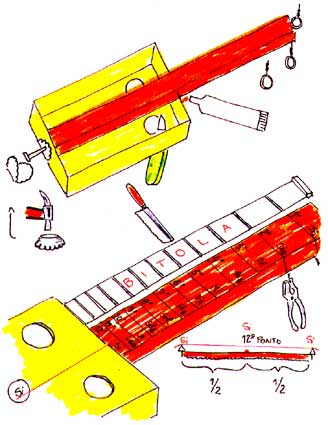|
|
 |
Violão (Classical Guitar)
ONCE UPON A TIME...
If you know what a guitar looks like and then look at the photograph that we show here, you’ll soon reach the conclusion that there’s very little similarity between them. But, as the poet says, dreams are the stuff of life. 1 was about 11 years old when my father gave me my first guitar. Shortly afterwards, 1 formed my own group, where my imagination and lack of money acted as a great spur to my creativity. Everything 1 found was in some way useful for making a musical instrument. By way of curiosity, the word VIOLÂO is used here in Portuguese, because this is how we distinguish the classical guitar (the Violão) from the smaller guitars, known as “wire guitars”, which are closer to what we call the BRAGUESA, CAMPANIÇA, etc... The most important document written about the most direct ancestor of the Violão, the vihuela, dates back to 1555 and was written by Juan Bermudo.
MATERIAL NEEDED
A large cardboard box, a strip of pine measuring 1 x 0,4 x 0,2 m, 2 m of wire, 3 screw-in hooks, 3 nails, a bottle-top, an old felt-tip pen and some steel wire or 3 steel guitar string.
TOOLS AND ACCESSORIES
A dovetail saw, a penknife, a compass, a hammer, a pair of pliers, a punch, a half-round file, some sandpaper (Nº. 150) and some contact adhesive.
HOW TO MAKE THE INSTRUMENT
First begin by preparing the lid of the box. Take a compass and draw two circles on it and then open up the holes with a penknife. Your Violão has two mouths and needs a lot of food. After this, smooth out the rough edges with the file and the sandpaper. Stick and nail the wooden strip right down the inside of the lid. Flatten out a bottle top and nail this at the end of the box where the strip of wood touches against the side. Glue the whole of this structure to the bottom part of the cardboard box. At the top end of. the wooden strip, screw in the 3 hooks, which will be used to stretch the strings.. If you want your guitar to have a TEMPERED SCALE (i.e. a scale that is divided into demitones), which is obtained by using small metal bars known as frets, then you need to get yourself a model or template. Take a photocopy of the fretboard of a guitar. The FRETBOARD is the part of the GUITAR, where the metal bars - or frets - are placed and over which the strings pass. Cut out this fretboard, which you will then use as your template, so that you can make a few small scratches on the surface with your handsaw, which will then serve as a guide for the wire. The purpose of this wire is to divide the fretboard (the strip of pine) into demitones, i.e. to serve as the frets. Finally, place the 3 steel strings in position. Your VIOLÃO tunes from the highest to the lowest pitch as follows - MI, SI, SOL, RE, LA, MI (bass string). As your guitar has two mouths, it has less strings. Because of this, you can only use the first three notes in the tuning - MI, TI, SOL. The strings must pass over the bridge (the felt-tip pen cut in half) and the position of this on the lid of the cardboard box has to be very precise. The distance from the nut (the first wire on which the string is supported) to the 1 2 th fret has to
